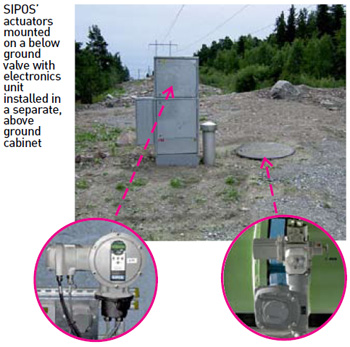Sipos claims finding solution to synchronise valve stems and valve characteristic innovation to enhance actuator functionality
Sipos claims finding solution to synchronise valve stems and valve characteristic innovation to enhance actuator functionality
Pointing out that traditionally, a mechanical process links two gearboxes to one actuator, but the approach is frequently satisfactory, as the stems can be a considerable distance apart, Sipos Aktorik has announced that it has addressed the problem of synchronisation of valve stems. Revealing that it has found a solution to the automation problem, the company said that the synchronisation solution has been achieved without the need of special programming in an external PLC.
Sipos explained how it works: A master actuator receives its control signal from the PLC (Open/Close, Profibus or Analogue). The setpoint is transmitted from there to the valves via a 4-20 mA loop, ensuring the valves receive the control information simultaneously. To ensure optimal performance, actuator operation is monitored internally at two levels. At the first level, if deviation is larger than a programmable value, then a “slow” signal is generated, and at the second level, a “stop” signal is transmitted.
 According to Sipos, unless these measures are taken, mechanical problems due to pre-programmed one-sided loads can occur, such as canted penstocks or twisted stems, which are costly and time-consuming to resolve. Additionally, if site conditions mean that valve stems cannot be coupled mechanically, then issues can extend beyond synchronisation of the two stems to include operation of more than one valve or gate.
According to Sipos, unless these measures are taken, mechanical problems due to pre-programmed one-sided loads can occur, such as canted penstocks or twisted stems, which are costly and time-consuming to resolve. Additionally, if site conditions mean that valve stems cannot be coupled mechanically, then issues can extend beyond synchronisation of the two stems to include operation of more than one valve or gate.
In another announcement, the company has claimed that a new functionality has been introduced to the Sipos 5 Flash actuator series, and therefore, it is now possible to adapt a linear position value, as determined by the DCS, to nonlinear valve characteristics. The development, said Sipos, would mean that Linear, Quick Opening and Equal Percentage functions can now be set via the local control station or ComSIPOS software.
The innovation of valve linearisation, along with the existing setting options that include “travel-positioning time characteristics”, “travel-speed setting” and “analogue speed control”, mean the product can be used to improve the modulating behaviour of complex systems, the manufacturer claimed. Additionally, valuable calculation time of the host DCS can be saved by using its intelligent actuators, it said.
Copyright © 2006-2025 - CPI Industry. All rights reserved.